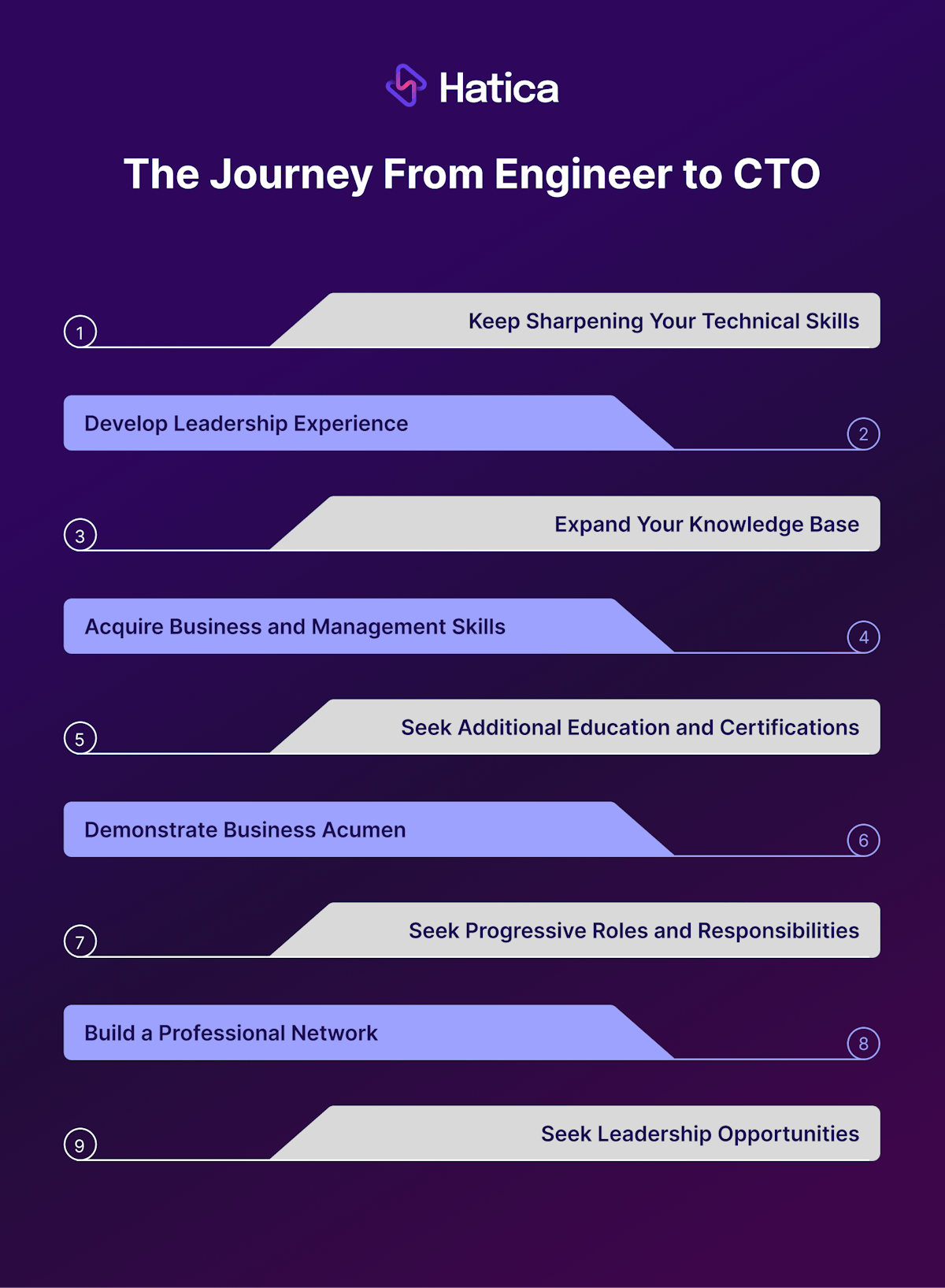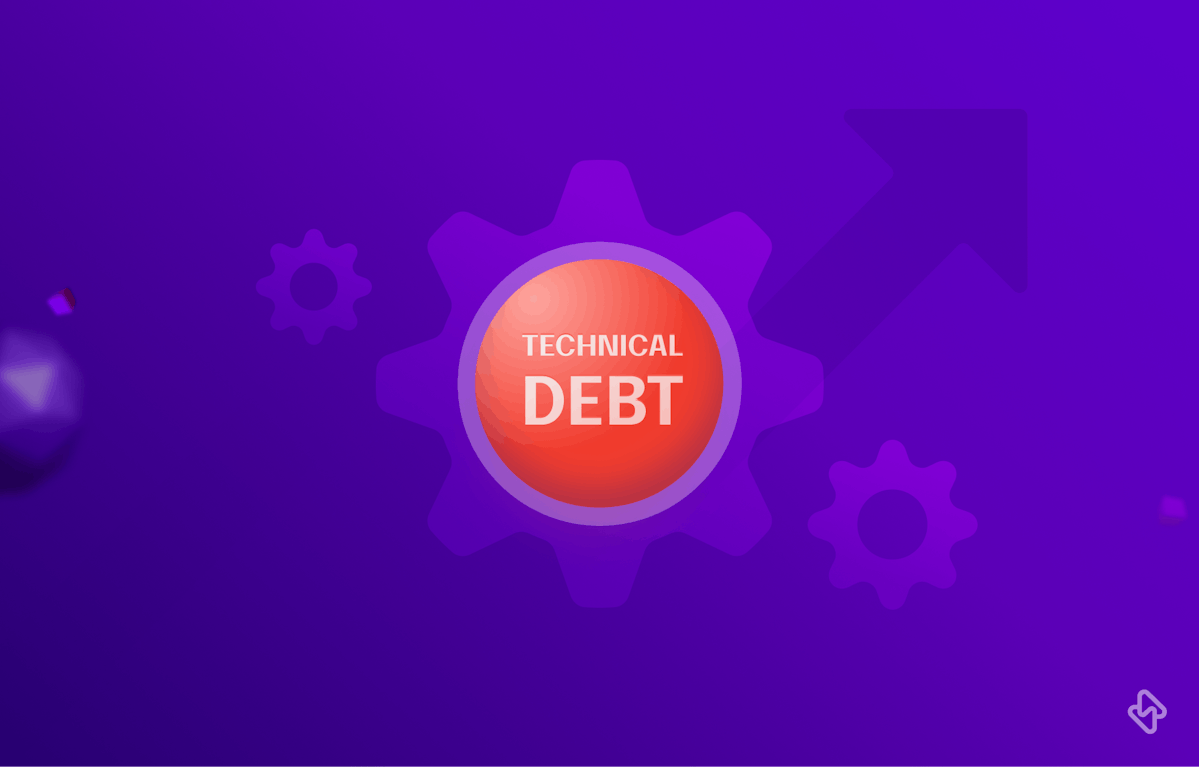1. Chief Technology Officer (CTO)
The CTO is like the captain, steering the ship of technology strategy, providing visionary leadership, and ensuring that all tech initiatives align seamlessly with the company’s overarching goals.
2. Technology Leadership Team
In bustling companies on the rise, the CTO gets a support crew! A team of tech leaders, including the likes of a VP of Engineering or IT Director, collaborates to manage specific areas within the CTO Office.
3. Software Development Team
Meet the digital architects! This team is on a mission – designing, developing, and maintaining software tailored for the company. They're the wizards who collaborate across departments to conjure up software solutions aligned with business goals.
4. Infrastructure Team
This team handles the nitty-gritty of hardware and software infrastructure – servers, networks, and cloud services. Their mission? Ensuring everything runs smoothly, stays secure, and scales up when needed.
5. Data and Analytics Team
Managing data assets, crunching numbers, and serving up data-driven insights for revolutionary decision-making. They're not just about data – they're the guardians of its security too.
6. Cybersecurity Team
The Cybersecurity Team acts as the company’s digital fort from potential threats and breaches. They're the ones implementing security measures, conducting audits, and spreading the gospel of data protection.
7. Innovation and Research Team
This team explores the aspect of emerging technologies, conducts experiments, and drives innovation. Collaborating with other teams, they're the dreamers pushing the boundaries of what's possible.
8. Project Management Office
This team primarily oversees the planning, execution, and monitoring of tech projects. They ensure projects set sail on time, stay within budget, and hit the quality jackpot.
9. User Experience and Design Team
These digital artists craft delightful user experiences for the company’s digital offerings. They're the ones working hand-in-hand with development and innovation teams to make interfaces user-friendly and visually appealing.
10. Vendor Management and Partnerships
As the title suggests, this help helps in managing ties with tech vendors and strategic partners. They evaluate potentials, negotiate like pros, and ensure partnerships align seamlessly with the company’s tech roadmap.
Remember, this is just a sneak peek, and the actual setup might have its unique twists and turns. In smaller start-ups, the CTO might even be the hands-on maestro overseeing multiple teams. The tech symphony plays differently everywhere!
What is the Journey to Become a CTO?
We’ll keep this very simple and start with the very basics. To become a CTO, this is what you’d need: Relevant Education + Relevant Experience + Leadership and People Skills + Technical Proficiency + Connection with Industry Leaders.
To become a standout CTO with a solid education foundation, start with a degree in computer science, and think about leveling up with a post-graduate gem like an MSc. in Computer Science or an MBA. Remember, while degrees are great, real skills and hands-on experience are your secret weapons. Dive into significant years of practical expertise,
Now, here's your golden ticket – networking. Connect with a diverse crew, link up with industry leaders, and voila! While the roadmap sparkles with possibilities, let's be real – each step demands dedication, effort, and a continuous commitment to growth.
Stage 0: Are you an ideal engineer/developer who could be a future CTO?
Nothing can drive you faster to the top of the ladder than the DRIVE within you.
Who are you?
Are you a frontend or backend web/mobile developer? A full-stack developer? Game developer? Blockchain developer? Cloud engineer? A DevOps professional? Security auditor? QA engineer?
Embedded Systems engineer? AR/XR? AI/ML? Data engineers? Did I miss any engineering roles? I guess not. Anyway, the point is, whosoever you’re, you can definitely be a CTO tomorrow.
But there are constraints.
1. You should be highly passionate & driven towards learning technologies, and everything related to it. The best of the breed type. The maniac type. At least in your early days.
2. You should be willing to give up full-time coding in the future and develop business acumen as you grow in your career (and yet breathe code!). Yeah, that means a lot of meetings, analytics & reporting, strategy, hiring, and problem-solving.
3. You must become a people person, while not letting go of your love for tech. To be precise, you’ve to be good at tech, business, and leadership skills.
What? Nobody ever said that becoming a CTO is a cakewalk. Actually, it depends on your mindset. There are different types of developers, and one of them is more suited to be a future CTO
- You would find developers who run backward with all their might at the first sight of a bug. Doesn’t matter then, whether they took a shot at solving the bug or not. They’re just not made for coding. But we all have to fill our stomachs and discharge our family duties. Well, these are not the ideal guys to become CTO or lead your engineering. Because with such attitude they can never be damn good at building tech. Of course, unless there is a tectonic shift in their attitude, mindset, and approach towards technology.
- Then there are developers, who are in the game for fun. They just love bugs. In fact, they are at their best selves when they see a bug. They are so much in the game that Stackoverflow is their last option, not the first. In fact, they spend so much time with bugs that you’ll often find these guys bugging senior engineers (no pun intended, the pain is real), asking them about tech stuff that these seniors have no clue about (if you’re a senior developer, you know the pain, Lol).
But this sort of passionate developer has 2 breeds.
- One who is way too attached to tech, and won’t bother even if someone drops a bomb next to them (just exaggerating). They are true geeks, or who we call nerds (with all due respect).
- The second type of developers are the ones who are equally intrigued about the business aspects of what they do. Yup, the kind of developer who asks business-related questions in meetings to the scrum masters. The developer, who questions the UI element choices of the designers, or if the functionality will actually drive any user engagement. One who doesn’t fumble cross-questioning the tech lead, or product manager. This is the ideal candidate for the future CTO. A perfect blend of tech & business. But wait… it’s not that simple. The journey of such developers has just started.
Stage 1: Eat Code. Drink Code. Breathe Code. RepEAT
In this stage, your focus should be to become a pro techie. You’ll be transitioning from associate (Jr) to senior developer roles. You may also switch domains — from development to DevOps, automation, security, networking, etcetera.
As a CTO, you have to know it all, and also get comfortable with not knowing it all. And before you become the CTO, you’ve to become that senior engineer who just puts his/her nose into everything — end-to-end engineering.
Being a good developer is not enough to become a CTO. You need to understand engineering holistically, like the back of your hand. Or maybe, better.
From physical rack-mount servers to cloud data centers and computing clusters. From simple API authentication & authorization (hey OAuth & JWT) logic to encryption & cryptography, security headers (CSP, CORS) & security aspects (DDoS, XSS, CSRF), etcetera. You should have a fair understanding & experience in hands-on ‘everything development’. Including,
- DevSecOps (CI, CD, IaC, Testing, Monitoring) & GitOps
- Cloud (containerization, virtualization, private, public, hybrid infrastructure)
- Networking (VPNs, CDNs, Load balancers)
- Modern software development paradigms (microservices, serverless, graph DB, docker, Kubernetes)
- Emerging tech (AI, generative models, blockchain, XR, voice technologies, and quantum computing)
- Regulations & Policies (GDPR)
Way too much for one life. Right? Well, you don’t need to master them all. You just need to understand them thoroughly. Because when you jump from a developer to a CTO-level job, there are no IFs & BUTs. No assumptions. At a position as high as CTO, the room to make mistakes is paper-thin. Because a lot is at stake.
This is also the stage where you should make yourself familiar with developer productivity, developer experience, and developer well-being concepts. Because that’s going to help you a lot in the process of becoming a CTO. Make sure that your organization uses engineering analytics tools. In fact, you too, as an aspiring CTO, must have insights into your own individual productivity, and the overall engineering health of the organization.
Cool. So, you must be wondering, will this complete your training to be the CTO?
Umm, not yet.
Stage 2: Taking Up the Tech Lead Mascot
This is the phase after you’ve displayed your prowess with tech.
Now, you would want to put your people skills to the test, while further bolstering your equation with the tech. This would need you to hone tactical & effective communication skills.
At this stage, you can take up the tech lead role. And subsequently, the engineering manager role.
We’ve discussed in detail the roles and responsibilities of tech lead vs engineering manager. Do give it a read to find out the differences, and how to excel at the respective roles.
Once you’re a tech lead,
- You’re not just responsible for your individual success but for the entire team.
- You also have to nurture new engineers and help them excel.
- You’ve to work along with engineering managers, product managers, and project managers (depending on the organizational structure).
Next, your natural progression is to transition from the tech lead to the engineering manager role. Now, the responsibilities have expanded.
A tech lead, ideally, is responsible for one team i.e., his own. As an engineering manager, you’re responsible for multiple teams. Here’s a glimpse into what it’s like to be an engineering manager:
- You’ve to allocate engineers to different projects, negotiate with tech leads to take up a project and convince them to complete the project with the available set of engineers (sometimes, peeps who they might not want to work with) in a given time frame.
- Also, there are situations where you could foresee a tech lead & his/her team expressing disappointment with you, yet you’ve to deal with it. Because this is no YouTube ad, and there ain’t any SKIP button. For instance, taking away a highly skilled engineer from an ongoing project & allocating to a new project or a project in escalation.
- The relationship with the project managers is also a little tight, especially when you have to convince them to accept new change requests, feature development requests, etcetera.
Do you see? People's responsibilities are a little delicate. You never know, when the lines have been crossed, and you might see a resignation letter in your inbox, or on your table, the next morning.
So, you got to master people skills. Get great at communication, negotiation, and conflict resolution. You need to get the word across the table while ensuring folks do not leave the table. Anyway, this is not the end yet. You’ve quite a few more responsibilities as an engineering manager.
You’ve to ensure that every single engineer is at their best productivity level. Ensure that they never get into the claws of burnout. And this is where our magical tool enters the picture.
You can make use of Hatica — an engineering analytics tool to gain insights into your engineering health. On a high level, Hatica helps you with
Align Your Engineering to the Business Strategy & the Bottom Line
Hatica integrates well with all the apps of your engineering toolchain including CI/CD platforms (Circle CI, Harness) incident management tools (PagerDuty, OpsGenie), communication tools (Slack, Zoom, G-suite), project management software, and Coding & repository management tools.
And what’s the benefit?
You get end-to-end visibility into your engineering processes & projects.
This helps you quantify & better analyze the subjective aspects of business that are tough to measure. For example, collaboration within a team. Of course, what you can quantify & measure is what you can improve. ‘Hatica Goals’ are exactly meant for the same. You can set goals (for example, reducing code churn to 5%) to improve engineering efficiency. Any deviations from set Hatica Goals could easily be detected, and that allows the teams to proactively mitigate issues.
For effective engineering & business alignment, you can use Hatica Goals in tandem with Dora metrics (MTBF, MTTD, MTTR, MTBD, CFR), Velocity metrics (Cycle time, code churn, PR metrics), and Well-being metrics (Maker time). Improving Dora Metrics can directly improve customer satisfaction, improving cycle time could mean more features being shipped frequently to the end customers and thus presenting opportunities for more sales, revenue, and customer loyalty. The same applies to improving well-being metrics which could save significant money slippage that happens due to employee churn.
Optimize Engineering Efficiency with Velocity Metrics
Hatica tracks 130+ engineering metrics including Cycle time, Deployment Frequency, Code churn, MTTR, PR size, PRs merged, average PR comment count, etcetera. Improving these directly helps you deliver more value, and improves overall engineering efficiency.
Deliver Joyful Developer Experience (DevEx)
Maker Time is a north star metric that most engineering organizations aspire to improve to ensure a joyful developer experience (DevEx). It’s a measure of the total time that the developer codes without interruption.
There are other metrics that you could bank on to improve the overall developer experience and ensure their well-being. For instance, Pickup time, active reviewers average, reviewer reaction time, submitter response time, involvement, etc. A high ‘involvement’, and high PRs merged or Lines of Code committed, or an increasing code churn for a developer or team could be a symbol of the team experiencing burn-out. This could be easily avoided by gaining data-driven insights from Hatica.
Well, this was the manager part of your role, where you make things simple for your own teams, and also help the senior authorities.
In addition to the people & manager role, you’ve to discharge your regular engineering duties:
- Ensure the right selection of tech stack & tech architecture for a given project
- Monitor the SDLC stages in progression, and ensure their smooth operation. You may want to audit the code quality on your own or make use of generative AI tools
- You may even want to sit with engineering teams, and talk to them, maybe help with bugs, etcetera. After all, Who doesn’t love a people’s leader?
And this brings us to the final phase of becoming a CTO.
Stage 3: The Bridge Between Engineering Efforts, and Business Goals
Becoming a CTO means breaking up with the CLIs & IDEs. But it’s not a final Bye, you’ll keep seeing your first love from time to time.
Right now, you’ve progressed in your career from a Jr developer >> associate >> senior engineer >> tech lead >> engineering manager.
Now, it’s the time when you become a VP of engineering.
The VP role doesn’t vary much compared to the engineering manager. It’s just that you’re not handling development teams directly. Because you’ve engineering managers for that.
So, what would you do then with ample free time? There is no free time. As VPs, the responsibilities increase further.
As a VP of engineering,
- You’ve to collaborate with the engineering managers across projects & product lines, ensuring that everything is in a healthy state.
- You’ve to attend meetings where engineering managers present reports about engineering efficiency, project status updates, infrastructure updates like uptime, downtime, attacks, new patches, the status of old issues, new challenges, individual team performance reviews, and any engineering operations-related update.
- You also have to collaborate with the executive team to help align your org’s business vision with tech-led strategy. Basically, perform feasibility analysis, and translate business requirements into engineering action plans.
- Next, collaborate again with engineering managers to execute strategic plans on the floor. It’s your job to provide your engineering managers with all the necessary tools, resources, technologies, and budget to get things done. So, you’ll be helping engineering managers in devising a roadmap, deciding on the tech stack, frameworks, etcetera. During project progression, you’ll hold regular project monitoring, risk identification, and mitigation meetings.
- Sometimes, you may need to facilitate cross-functional operations between the engineering, design, HR, and finance teams.
- And lastly, you’ve to report to the executives and engage stakeholders on technical matters.
- As a VP, who aspires to be a CTO, you have to keep sharpening your communication, people (empathy), tech, and business acumen. You also need to hire & train new engineers. Focus on becoming more pragmatic, less radical, and more real.
If you didn’t realize, you will have no time to sit and code. This is the stage where you’ve to let go of your obsession with code and focus on the business-focused engineering aspects that keep the organizational wheels moving.
Basically, with this sacrifice, you’re ready to don the CTO crown.
Final Stage: CTO Crowning Ceremony
Uhm, look who is about to get a dedicated cabin.
Well, don’t want to spoil your enthusiasm, but whether you get a cabin or not would depend on organizational size & culture. Some prefer an open-table working culture, with no hierarchy. Some go the traditional way.
Anyway, typically, once you’ve proven your mettle at the VP level. You get rewarded with a sumptuous salary hike and a lot of respect within the corporate circle.
But your real job starts now.
As CTO,
- You’re responsible for everything that a tech lead, engineering manager, and VP is responsible for.
- Plus, you need to steer your organization towards new technological milestones, handpick your organizational tech stack, and infrastructure components, align tech with business, crunch numbers to assess profitability, decide the suite of products that you build for your customers, add new features to the existing products, cutting loose non-performing applications, engage stakeholders, devise a strategy to out-compete competitors, build a culture of innovation, automation, and technological excellence.
- Besides, foresee market conditions, and upcoming technological disruptions, and accordingly shape your own organization, and help the clients as well to prepare for the same.
- Also, work with sales, marketing, finance, development, operations, legal departments, media, and stakeholders. You need to know what sales guys have promised to the clients, how marketing people are planning to launch the new product, the positioning etcetera, and if there are any legal issues that are arising from any of the organizational initiatives.
In short, you need to be the best at all three — people, tech, and leadership.
Yes. You really thought CTO is a crown? It’s not. It’s a bag full of responsibilities and surprises. Good Luck, CTO.
The journey of such developers has just started, and if you're aspiring to become a CTO one day, you'll find valuable insights on preparing for that role in this CTO board presentation slides guide!
Your CTO Roadmap: From Engineer to Leader
When an engineer finally assumes the role of a CTO, they are no longer just responsible for lines of code. They are instrumental in shaping the company's technology roadmap, aligning it with business goals, and driving innovation.
Technology will keep advancing, industries will keep changing, and the role of a CTO will continue to evolve alongside them. By embracing challenges, seeking continuous improvement, and fostering innovation, CTOs shape the technological landscape for years to come.
So, for those driven by the passion to shape the future through technology, the path from engineer to CTO is an exciting and fulfilling expedition, characterized by growth, innovation, and boundless opportunities.







